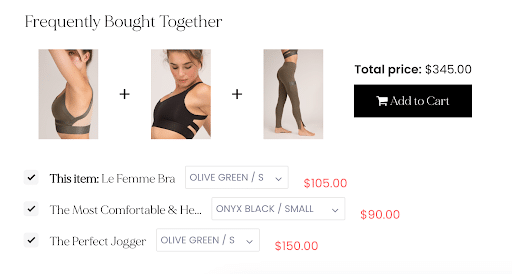Merchandising isn’t just for brick and mortar—your digital storefront also needs some creative TLC to maximize sales and tell your brand story.
The Ultimate Guide to Ecommerce Merchandising
This article is part of a larger series on Retail Management.
Merchandising is the practice of promoting goods and/or services for sale and dictates the visuals, placement, pricing, and even targeting of products. Retail merchandising in a brick-and-mortar setting involves product displays, signage, and other in-store features. Ecommerce merchandising applies this concept to your online store.
Below, find out what ecommerce merchandising is, why it’s important, and how to do it effectively.
What Is Ecommerce Merchandising?
Ecommerce merchandising is the practice of strategically presenting products online across each commerce and marketing channel. Creating visual displays, product categories, promotions, and personalized recommendations are a few ways to approach ecommerce merchandising.
Why Ecommerce Merchandising Is Important
Ecommerce merchandising is important online just like visual merchandising is important in the retail setting. Here are a few reasons:
- Drives engagement: Visually appealing ecommerce merchandising makes shoppers more likely to engage with your content. This could be in the form of comments and shares on social media, click-throughs on paid ads or emails, and add-to-carts on your store.
- Increases sales: At the end of the day, every business is interested in more sales. Ecommerce merchandising is one way to achieve this. More engagement means more opportunities to capture the sale.
- Reinforces your brand: When ecommerce merchandising is synonymous with your visual branding, it creates more recognition and awareness.
Ecommerce Merchandising in Action: 8 Arrows
See how activewear brand 8 Arrows approaches its ecommerce merchandising. Product photos are similar in look and feel, whether it’s for the email signup, homepage banner, or product recommendations on a product description page (PDP).
Best Practices for Your Ecommerce Merchandising Strategy
Your ecommerce merchandising strategy and your marketing strategy are not the same. It’s important to embrace ecommerce merchandising-specific best practices when approaching this aspect of your business.
Embrace Personalization
Personalization is an effective way to connect with shoppers and make them feel an emotional connection to your brand. You can incorporate personalization into your ecommerce merchandising strategy to double down on these benefits. About 56% of consumers say they’re more likely to become repeat buyers after a personalized shopping experience with a brand.
You could recommend products related to the user’s previous purchases and behaviors rather than a universal product recommendation widget that shows the same items for everyone on every page.
Or, switch out your visuals depending on the region where users are located. If they’re in warm, coastal destinations, use similar imagery. If they’re in a mountainous area, feature those landscapes in your visuals. You can use targeting options in many advertising and marketing platforms.
Cross-merchandise Related Products
Cross merchandising is when you display products from different categories together to incentivize multi-item purchases. It reminds customers of a need, sparks ideas, and streamlines the shopping process. You can do this online with product group shops, collection pages, and recommended product modules.
Consider SEO
SEO is important for ecommerce because it helps your website and products gain visibility in organic web searches. As it relates to ecommerce merchandising, you want to build a strategy that supports your existing SEO efforts. You should also take SEO insights into account and adjust your merchandising when necessary.
For example, you might sell clothing and notice a search opportunity for “winter jackets for kids.” Perhaps you create a collection or landing page of all the children’s winter jackets you have available for sale. This creates synergy among products, boosts visibility and SEO, and provides an easy browsing and comparison shopping experience for users.
Learn more:
Measure Ecommerce Success
It’s always important to track the performance of your efforts so you can learn what’s working—and do more of that—and learn what’s not working—and fix that. When looking at the success of your ecommerce merchandising, consider the following ecommerce analytics:
- Click-through rate (CTR): Are the visuals appealing enough to make shoppers click?
- Basket size: Are cross-merchandising and personalization persuading shoppers to add more items to their cart?
- Cart abandonment rate: Is your checkout experience intuitive and simple?
- Engagement rate: Do people like your content enough to comment on or share it?
- Sales: Simply put, are you selling more of the items you’re prioritizing in your ecommerce merchandising strategy?
Trends Shaping Ecommerce Merchandising in 2024
When done correctly, merchandising, especially online merchandising, should reflect the interests, needs, and wants of the consumer. And, effective merchandising should make it easier for shoppers to discover and buy products.
Here are some of the key trends to keep in mind for your ecommerce merchandising strategy:
AI & Automation Are Integral to Ecommerce
Artificial intelligence (AI) is transforming virtually every industry, especially ecommerce. Businesses and consumers alike are optimistic about the technology—73% of consumers prefer local retailers to automate at least one task in their purchase journey instead of using staff, while 44% want an automated tool to get more product information and availability.
Take advantage of AI by using automated and intelligent features available in the tools and platforms you already use. This can help you embrace the technology with an easier learning curve.
For example, this can take the form of:
- Personalized product recommendations
- Tailoring offers specific to each shopper
- Cross-selling and up-selling at checkout
Related:
Consumers’ Expectations Are Getting Higher
Consumers know technology is advancing and making it easier than ever to run an integrated, strategic business. As they warm up to the idea of using technology like AI and personalization, they’re also expecting more from businesses.
Higher expectations impact ecommerce merchandising because customers want brands to be smarter and more targeted in their efforts.
For example, a customer who purchases your specific chemical-free women’s deodorant every month doesn’t want to receive a promotional email from you touting that same deodorant and asking subscribers if they’ve tried it yet.
Instead, use smart technologies to exclude them from the list, and only send the promotional email to people who have yet to try that particular product. For your existing customers, maybe send an email about the chemical-free chapstick and sunscreens you also sell.
Learn more about consumer behavior:
Frequently Asked Questions (FAQs)
These are some questions people often ask about ecommerce merchandising.
Ecommerce merchandise refers to any product or item available for sale via some sort of digital sales channel. Ecommerce merchandise can be sold and purchased directly from company websites, through marketplaces like Amazon, on social media, and via other selling channels.
An ecommerce merchandising specialist does the following:
- Manage the product catalog and maintain accurate product descriptions, images, prices, and availability
- Create and implement strategies to display products online to attract and engage customers. They may put products into categories, set up promotional banners, or design landing pages.
- Analyze sales data, customer behavior, and market trends to make informed decisions about product placements, promotions, and pricing strategies.
- Make sure product pages are optimized for SEO.
- Execute promotional campaigns, including sales events, discount offers, and special promotions to boost sales.
- Collaborate with marketing, sales, and inventory teams to ensure alignment on product launches, promotions, and stock levels.
Bottom Line
Ecommerce merchandising is an incredibly important part of running a successful online business, and you’re probably already doing it without even realizing it. Now that you know what ecommerce merchandising is, you can be more intentional and strategic in your efforts. Think about how and where you want to place your products online, and what that means for the customer journey.



